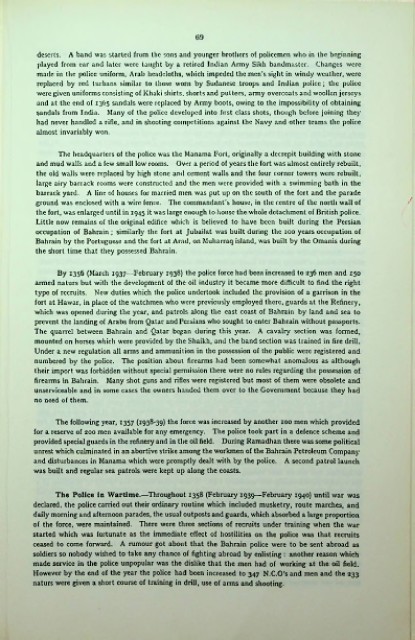Page 353 - Bahrain Gov Annual Reports (III)_Neat
P. 353
(59
deserts. A band was started from the sons and younger brothers of policemen who in the beginning
played from car and later were taught by a retired Indian Army Sikh bandmaster. Changes were
made in the police uniform, Arab hcadcloths, which impeded the men’s sight in windy weather, were
replaced by red turbans similar to those worn by Sudanese troops and Indian police ; the police
were given uniforms consisting of Khaki shirts, shorts and puttees, army overcoats and woollen jerseys
and at the end of 1365 sandals were replaced by Army boots, owing to the impossibility of obtaining
sandals from India. Many of the police developed into first class shots, though before joining they
had never handled a rifle, and in shooting competitions against the Navy and other teams the police
almost invariably won.
The headquarters of the police was the Manama Fort, originally a decrepit building with stone
and mud walls and a few small low rooms. Over a period of years the fort was almost entirely rebuilt,
the old walls were replaced by high stone and cement walls and the four comer towers were rebuilt,
large airy barrack rooms were constructed and the men were provided with a swimming bath in the
barrack yard. A line of houses for married men was put up on the south of the fort and the parade
ground was enclosed with a wire fence. The commandant’s house, in the centre of the north wall of
the fort, was enlarged until in 1945 it was large enough to house the whole detachment of British police.
Little now remains of the original edifice which is believed to have been built during the Persian
occupation of Bahrain; similarly the fort at Jubailat was built during the 100 years occupation of
Bahrain by the Portuguese and the fort at Arad, on Muharraq island, was built by the Omanis during
the short time that they possessed Bahrain.
By 1356 (March 1937—February 1938) the police force had been increased to 236 men and 150
armed naturs but with the development of the oil industry it became more difficult to find the right
type of recruits. New duties which the police undertook included the provision of a garrison in the
fort at Hawar, in place of the watchmen who were previously employed there, guards at the Refinery,
which was opened during the year, and patrols along the cast coast of Bahrain by land and sea to
prevent the landing of Arabs from Qatar and Persians who sought to enter Bahrain without passports.
The quamel between Bahrain and Qatar began during this year. A cavalry section was formed,
mounted on horses which were provided by the Shaikh, and the band section was trained in fire drill.
Under a new regulation all arms and ammunition in the possession of the public were registered and
numbered by the police. The position about firearms had been somewhat anomalous as although
their import was forbidden without special permission there were no rules regarding the possession of
firearms in Bahrain. Many shot guns and rifles were registered but most of them were obsolete and
unserviceable and in some cases the owners handed them over to the Government because they had
no need of them.
The following year, 1357 (1938-39) the force was increased by another 100 men which provided
for a reserve of 200 men available for any emergency. The police took part in a defence scheme and
provided special guards in the refinery and in the oil field. During Ramadhan there was some political
unrest which culminated in an abortive strike among the workmen of the Bahrain Petroleum Company
and disturbances in Manama which were promptly dealt with by the police. A second patrol launch
was built and regular sea patrols were kept up along the coasts.
The Police in Wartime.—Throughout 1358 (February 1939—February 1940) until war was
declared, the police carried out their ordinary routine which included musketry, route marches, and
daily morning and afternoon parades, the usual outposts and guards, which absorbed a large proportion
of the force, were maintained. There were three sections of recruits under training when the war
started which was fortunate as the immediate effect of hostilities on the police was that recruits
ceased to come forward. A rumour got about that the Bahrain police were to be sent abroad as
soldiers so nobody wished to take any chance of fighting abroad by enlisting : another reason which
made service in the police unpopular was the dislike that the men had of working at the oil field.
However by the end of the year the police had been increased to 347 N.C.O’s and men and the 233
naturs were given a short course of training in drill, use of arms and shooting.

